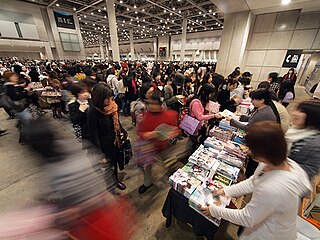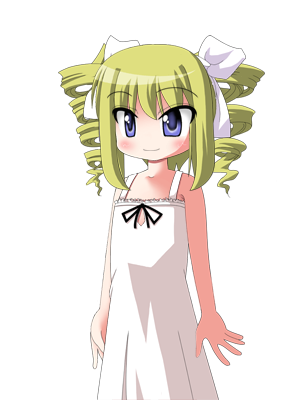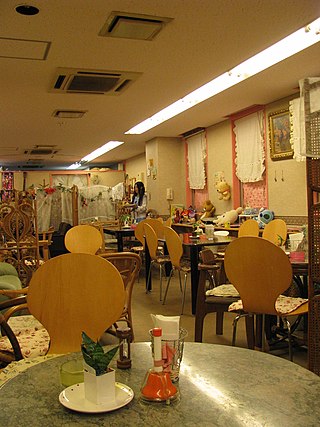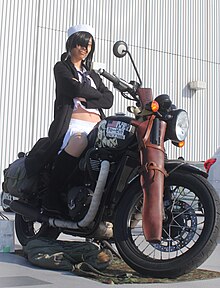
Akihabara is a neighborhood in the Chiyoda ward of Tokyo, Japan, generally considered to be the area surrounding Akihabara Station. This area is part of the Sotokanda (外神田) and Kanda-Sakumachō districts of Chiyoda. There is an administrative district called Akihabara, located north of Akihabara Electric Town surrounding Akihabara Neribei Park.

Otaku no Video is a 1991 Japanese original video animation (OVA) produced by Gainax. The anime spoofs the life and culture of otaku, individuals with obsessive interests in media, particularly anime and manga, as well as the history of Gainax and its creators. It is noted for its mix of conventional documentary film styles with a more traditional anime storytelling fashion. It is licensed in the United States by AnimEigo. The DAICON III and IV Opening Animations from the early 1980s are also featured in this OVA.

In Japanese popular culture, lolicon is a genre of fictional media which focuses on young girl characters, particularly in a sexually suggestive or erotic manner. The term, a portmanteau of the English-language phrase "Lolita complex", also refers to desire and affection for such characters, and their fans. Associated mainly with stylized imagery in manga, anime, and video games, lolicon in otaku culture is generally understood as distinct from desires for realistic depictions of young girls, or real young girls as such, and is associated with moe, or affection for fictional characters, often bishōjo characters in manga or anime.

In Japanese popular culture, a bishōjo, also romanized as bishojo or bishoujo, is a cute girl character. Bishōjo characters appear ubiquitously in media including manga, anime, and computerized games, and also appear in advertising and as mascots, such as for maid cafés. An attraction towards bishōjo characters is a key concept in otaku subculture.

In Japan, doujin is a group of people who share an interest, activity, or hobby. The word is sometimes translated into English as "clique", "fandom", "coterie", "society", or "circle". Self-published creative works produced by these groups are also called doujin, including manga, magazines, novels, music, anime, merch, and video games. Print doujin works are collectively called doujinshi.

Moe, sometimes romanized as moé, is a Japanese word that refers to feelings of strong affection mainly towards characters in anime, manga, video games, and other media directed at the otaku market. Moe, however, has also gained usage to refer to feelings of affection towards any subject.

Tsundere is a Japanese term for a character development process that depicts a character with an initially harsh personality who gradually reveals a warmer, friendlier side over time.
The following is a glossary of terms that are specific to anime and manga. Anime includes animated series, films and videos, while manga includes graphic novels, drawings and related artwork.

Akiba-kei or Akiba-chan (アキバちゃん) is a Japanese slang term for Akihabara style. Akihabara is a district in Chiyoda, Tokyo. It is a prominent gathering place for dedicated fans of anime, video games and idols.

Maid cafés are a subcategory of cosplay restaurants found predominantly in Japan and Taiwan. In these cafés, waitresses, dressed in maid costumes, act as servants, and treat customers as masters as if they were in a private home, rather than as café patrons. The first permanent maid café, Cure Maid Café, was established in Akihabara, Tokyo, Japan, in March 2001, but maid cafés are becoming increasingly popular. The increased competition drove the cafes to employ more diversified themes, gimmicks and even unusual tactics to attract customers. They have also expanded overseas to several countries around the world.

Otome Road is a name given to an area of Ikebukuro, Tokyo, Japan that is a major shopping and cultural center for anime and manga aimed at women. The area is sometimes referred to as Fujoshi Street, referencing the name given to fans of yaoi.

Boys' love (BL), a genre of male-male homoerotic media originating in Japan that is created primarily by and for women, has a robust global fandom. Individuals in the BL fandom may attend conventions, maintain/post to fansites, create fanfiction/fanart, etc. In the mid-1990s, estimates of the size of the Japanese BL fandom were at 100,000 to 500,000 people. Despite increased knowledge of the genre among the general public, readership remained limited in 2008.

Eiji Ōtsuka is a Japanese social critic, folklorist, media theorist, and novelist. He is currently a professor at International Research Center for Japanese Studies, Kyoto. He graduated from University of Tsukuba with a degree in anthropology, women's folklore, human sacrifice and post-war manga. In addition to his work with manga he is a critic, essayist, and author of several successful non-fiction books on Japanese popular and otaku subcultures. He has written the Multiple Personality Detective Psycho and The Kurosagi Corpse Delivery Service manga series. One of his first animation script works was Mahō no Rouge Lipstick, an adult lolicon OVA. Ōtsuka was the editor for the bishōjo lolicon manga series Petit Apple Pie.

Otaku no Musume-san is a manga series by Japanese author Stu-Hiro. It tells about a young 26-year-old otaku, who is suddenly visited by a young girl claiming to be his daughter. It was first serialized in Fujimi Shobo's shōnen manga magazine Monthly Dragon Age in 2006. The last chapter has been released in the 11th issue of Monthly Dragon Age on October 8, 2011.

The anime and manga fandom is a worldwide community of fans of anime and manga. Anime includes animated series, films and videos, while manga includes manga, graphic novels, drawings, and related artworks. The anime and manga fandom traces back to the 1970s and has an international reach.

The Otaku Encyclopedia is a 2009 encyclopedia written by Patrick Galbraith and published by Kodansha which provides an overview of anime and manga topics, and interviews and profiles of important people in Japanese fandom.
ACG is a term used in some subcultures of Greater China and East Asia. Because there is a strong economic and cultural interlinkage that exists between anime, manga, and games in Japanese and East Asian culture at large, the term ACG is used to describe this phenomenon in relative fields. The term refers in particular to Japanese anime, manga, and video games. The term is not normally translated into Chinese; if the meaning needs to be translated, it is usually "two-dimensional space"

Zettai ryōiki refers to the area of bare skin in the gap between overknee socks and a skirt or shorts. It can also be used to describe the clothing combination. The term first became widespread in otaku slang as one of the attributes of moe characters in anime and manga, but it is now used by the general public in Japan.

The International Otaku Expo Association (IOEA), stylized as I.O.E.A, is an international cooperative association of otaku fan event organizers from around the world. The term otaku is used to indicate enthusiasm for Japanese pop culture and subculture surrounding anime, manga, games and fashion. The association does not limit membership to events that focus solely on Japanese culture. Any association that wishes to embrace otaku culture, whether it be Japanese or non-Japanese, is welcome to apply for membership with the IOEA.
Database consumption refers to a way of content consumption in which people do not consume a narrative itself, but rather consume the constituent elements of the narrative. The concept was coined by the Japanese critic Hiroki Azuma in the early 2000s.




















